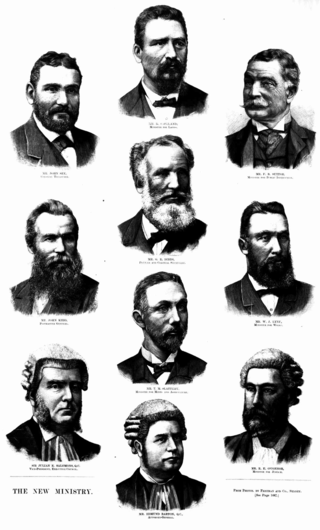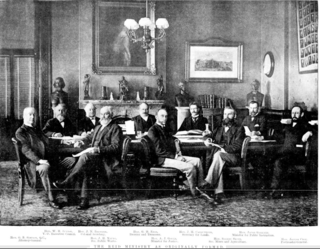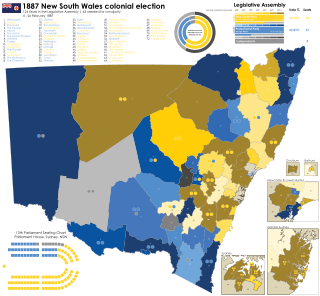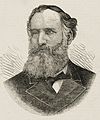
The New South Wales Legislative Assembly is the lower of the two houses of the Parliament of New South Wales, an Australian state. The upper house is the New South Wales Legislative Council. Both the Assembly and Council sit at Parliament House in the state capital, Sydney. The Assembly is presided over by the Speaker of the Legislative Assembly.

Sir George Richard Dibbs KCMG was an Australian politician who was Premier of New South Wales on three occasions.
Paddington was an electoral district of the Legislative Assembly in the Australian state of New South Wales, originally created in 1859, partly replacing Sydney Hamlets. It included the suburbs of Paddington and Redfern. The rest of Sydney's current Eastern Suburbs, which were then rural, were part of Canterbury. With the creation of the electoral districts of South Sydney and Redfern in 1880, Paddington included the northern part of the eastern suburbs, generally east of what is now known as Anzac Parade and north of Rainbow Street, including all of current Woollahra and Waverley and part of Randwick. It elected one member from 1859 to 1880, two members from 1880 to 1885, three members from 1885 to 1889 and four members from 1889 to 1894. With the abolition of multi-member constituencies in 1894, it was replaced by the single-member electorates of Paddington, Waverley, Woollahra and Randwick. In 1920, with the introduction of proportional representation, it was absorbed into Sydney. Paddington was recreated in 1927. In 1959, it was combined with part of Waverley and renamed Paddington-Waverley, which was itself abolished in 1962 and partly replaced by Bligh.
Members of the New South Wales Legislative Assembly who served in the 10th parliament of New South Wales held their seats from 1880 to 1882. Elections for the tenth Legislative Assembly were held between 17 November and 10 December 1880 with parliament first meeting on 15 December 1880. Electoral reforms passed by the ninth parliament had resulted in parliament being expanded to 108 members elected in 43 single member electorates, 25 two member electorates, 1 three member electorate and 3 four member electorates. In addition, electorates franchised on qualifications of occupation or education had been abolished. The parliament had a maximum term of 3 years but was dissolved after 23 months. Sir Henry Parkes continued as the Premier for the duration of the parliament. The Speaker was Sir George Allen.
Members of the New South Wales Legislative Assembly who served in the 11th parliament of New South Wales held their seats from 1882 to 1885. Elections for the eleventh Legislative Assembly were held between 30 November and 21 December 1882 with parliament first meeting on 3 January 1883. The Assembly was expanded to 113 members elected in 40 single member electorates, 26 two member electorates, 3 three member electorate and 3 four member electorates. The parliament had a maximum term of 3 years and was dissolved on 7 October 1885 after 33 months. The Premiers during this parliament were Sir Alexander Stuart until 7 October 1885 and then George Dibbs. The Speaker was Edmund Barton.

The third Parkes ministry was the nineteenth ministry of the Colony of New South Wales, and was led by Sir Henry Parkes in a coalition with Sir John Robertson. It was the third of five occasions that Parkes was Leader of the Government.

The Stuart ministry was the 20th ministry of the Colony of New South Wales, and was led by Sir Alexander Stuart. Stuart was elected to the New South Wales Legislative Assembly in 1874.
The first Dibbs ministry was the 21st ministry of the Colony of New South Wales, and was the first of three occasions of being led by the Premier, George Dibbs. Dibbs was elected to the New South Wales Legislative Assembly in 1874.
The fourth Parkes ministry was the 24th ministry of the Colony of New South Wales, and was led by the seventh Premier, Sir Henry Parkes. It was the fourth of five occasions that Parkes was Premier.

The fifth Parkes ministry was the 26th ministry of the Colony of New South Wales, and was led by the seventh Premier, Sir Henry Parkes. It was the fifth and final occasion that Parkes was Premier. The title of Premier was widely used to refer to the Leader of Government, but was not a formal position in the government until 1920. Instead the Premier was appointed to another portfolio, usually Colonial Secretary. Having served in the New South Wales Legislative Council between 1854 and 1856, Parkes was elected in the first free elections for the New South Wales Legislative Assembly held in 1856, however resigned from Parliament later that year. He served in the Assembly on several occasions, between 1858 and 1870, being forced to resign on 4 occasions due to his personal insolvency. He came to power as Premier on the first occasion in 1872, serving as Premier for a period of three years. However, Parkes lost the confidence of the Assembly following Governor Robinson's decision to release of the bushranger Frank Gardiner led to the defeat of the ministry in 1875.

The second Dibbs ministry was the 25th ministry of the Colony of New South Wales, and was the second of three occasions of being led by the tenth Premier, George Dibbs. Dibbs was elected to the New South Wales Legislative Assembly in 1874. In a period of great financial stress for the Colony, this ministry covers just 49 days from 17 January 1889 until 7 March 1889. Dibbs took over as Premier on the first occasion in October 1885 following resignation of the Alexander Stuart due to ill-health, with his ministry lasting for 75 days. Dibbs served as Colonial Secretary in the Jennings ministry, before it too suffered budgetary pressures. It was during this time that the party system was formed in New South Wales with Sir Henry Parkes leading the Free Trade Party. Dibbs had been elected as an independent free trader, however his opposition to Parkes caused Dibbs to align himself with the Protectionist Party. Dibbs had assumed office when Parkes lost a vote on the floor of the Assembly. Parliament was dissolved on 19 January 1889 and an election was held in February. There was a significant swing to the Protectionists, gaining 29 seats, however it was insufficient to command a majority of the Legislative Assembly and Parkes resumed the premiership.

The third Dibbs ministry, the 27th ministry of the Colony of New South Wales, was led by Sir George Dibbs, leader of the Protectionist Party, following the 1891 New South Wales election, which saw the Labour Party win seats in the New South Wales Legislative Assembly and the balance of power. With no party having a majority, Sir Henry Parkes held on as Premier until October 1891 when he lost a vote in the Legislative Assembly, causing Parkes to resign as Premier and leader of the Free Trade Party. Dibbs formed the ministry on 23 October 1891, with Labour support, and comprised 10 ministers.

The Reid ministry was the 28th ministry of the Colony of New South Wales, and was led by the 12th Premier, George Reid. The title of Premier was widely used to refer to the Leader of Government, but was not a formal position in the government until 1920. Instead the Premier was appointed to another portfolio, usually Colonial Secretary but on this occasion Reid took the portfolio of Colonial Treasurer until July 1899 and then Attorney General.
Canterbury, an electoral district of the Legislative Assembly in the Australian state of New South Wales has had two incarnations, from 1859 to 1920 and 1927 to the present.

The 1891 New South Wales colonial election was held in the then colony of New South Wales between 17 June to 3 July 1891. This election was for all of the 141 seats in the New South Wales Legislative Assembly and it was conducted in 35 single-member constituencies, 20 2-member constituencies, 10 3-member constituencies and nine 4-member constituencies, all with a first past the post system. Part 1 of the Electoral Act of 1880 set the qualification for election on "every male subject of Her Majesty of the full age of twenty-one years and absolutely free being a natural born or naturalized subject". Seven seats were uncontested. The previous parliament of New South Wales was dissolved on 6 June 1891 by the Governor, The Earl of Jersey, on the advice of the Premier, Sir Henry Parkes.

The 1894 New South Wales colonial election was held on 17 July 1894 for all of the 125 seats in the 16th New South Wales Legislative Assembly and it was conducted in single-member constituencies with a first past the post voting system. Section 23 (1) of the Parliamentary Electorates and Elections Act of 1893 conferred a right to vote on 'every male person, being a natural born [British] subject, who shall have resided or had his principal place of abode in New South Wales for a continuous period of one year'. The 15th parliament of New South Wales was dissolved on 25 June 1894 by the Governor, Sir Robert Duff, on the advice of the Premier, George Dibbs.

The 1887 New South Wales colonial election was held between 4 February and 26 February 1887. This election was for all of the 124 seats in the New South Wales Legislative Assembly and it was conducted in 37 single-member constituencies, 23 2-member constituencies, seven 3-member constituencies and five 4-member constituencies, all with a first past the post system. Part 1 of the Electoral Act of 1880 had awarded the right to vote to 'every male subject of Her Majesty of the full age of twenty-one years and absolutely free being a natural born or naturalized'. The previous parliament of New South Wales was dissolved on 26 January 1887 by the Governor, Lord Carrington, on the advice of the Premier, Sir Henry Parkes.
This is a list of candidates for the 1889 New South Wales colonial election. The election was held from 1 February to 16 February 1889.
This is a list of candidates for the 1887 New South Wales colonial election. The election was held from 4 February to 26 February 1887.
East Sydney, an electoral district of the Legislative Assembly in the Australian state of New South Wales was created in 1859 and abolished in 1894.













